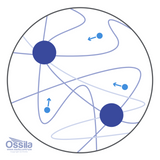HEPA Filter Size Chart

High efficiency particulate air (HEPA) filters are designed to efficiently remove airborne particles and contaminants, making them indispensable tools in laboratories and cleanroom facilities. A laminar flow hood uses a HEPA filter to create the contaminant-free workspace essential for sensitive experiments, pharmaceutical production, and other critical scientific processes.
Some filters claim HEPA status simply because the filter has a most penetrating particle size of 0.3 µm. However, HEPA filters should be certified against a well-defined standard in order to gain this title. The HEPA filter efficiency chart outlines the HEPA classes and groupings in terms of actual filtration efficiency.
HEPA Filter Efficiency
The exact definition of HEPA filter efficiency can lead to some confusion in both ASME and ISO standards. A common misconception is that the efficiency rating applies to all particles of all sizes (e.g., the filter will remove 95% of all particles from the air). Alternatively, the efficiency is often misunderstood as describing the best possible efficiency that a filter can achieve.
HEPA filter efficiency is defined at a particular particle size, known as the most penetrating particle size (MPPS). The MPPS is the particle size which will most readily passes through the filter material. For EPA, HEPA, and ULPA filters, the MPPS is around 0.3 µm in size. Therefore, the stated efficiency is often higher for both smaller and larger particles. It is counterintuitive that below the stated particle size the efficiency should increase, but it does.
Above are graphs that show the typical filtration efficiency curve of a HEPA filter. The minimum filtration occurs at 0.3 µm. This curve is produced by overlapping filtration mechanisms. Some mechanisms work only on particles greater than the size of the gaps within the filter while others only work on smaller particles.
HEPA Filter Efficiency Chart
HEPA filters should adhere to specific well-defined standards such as:
- ISO 29463-1:2011 High-efficiency Filters and Filter Media for Removing Particles in Air
- ASME AG-1 Code on Nuclear Air and Gas Treatment
For each standard, filters much achieve a minimum level of particle filtration to achieve HEPA status. For the ISO standards, the minimum filtration that is counted as ‘high efficiency’ is 99.95%. This means that 99.95% of particles are filtered from the air. For the ASME standard, they must remove at least 99.97% of particles, before they are classed as high efficiency. HEPA filters from Ossila capture up to 99.99% of particles.
The ISO standard provides a range of filter groups that include EPA, HEPA, and ULPA filters, and defines the minimum filtration efficiency for each group. The table summarizes the different groups along with the commonly used filter classification that each group falls under.
| Filter Class | Filter Group | Efficiency | PPM Penetration |
|---|---|---|---|
| E11 | ISO 15 E | ≥95% | 50,000 |
| E11 | ISO 20 E | ≥99% | 10,000 |
| E12 | ISO 25 E | ≥99.5% | 5,000 |
| E12 | ISO 30 E | ≥99.9% | 1,000 |
| H13 | ISO 35 H | ≥99.95% | 500 |
| H13 | ISO 40 H | ≥99.99% | 100 |
| H14 | ISO 45 H | ≥99.995% | 50 |
| H14 | ISO 50 U | ≥99.999% | 10 |
| U15 | ISO 55 U | ≥99.9995% | 5 |
| U15 | ISO 60 U | ≥99.9999% | 1 |
| U16 | ISO 65 U | ≥99.99995% | 0.5 |
| U16 | ISO 70 U | ≥99.99999% | 0.1 |
| U17 | ISO 75 U | ≥99.999995% | 0.05 |
The ‘PPM Penetration’ value is a percentage that represents the maximum amount of MPPS particles that can completely penetrate the HEPA filter. This value is shown in parts per million (ppm) and is directly related to the efficiency. The ‘Efficiency’ represents the percentage of MPPS particles that a filter will absorb or intercept.
Laminar Flow Hood

Learn More
 ULPA vs HEPA Filters: Which One is Right for You?
ULPA vs HEPA Filters: Which One is Right for You?
Ultra-Low Particulate Air (ULPA) and High-Efficiency Particulate Air (HEPA) filters are both used in laminar flow hoods to remove particles from incoming air.
Read more... Laminar Flow Hoods: ISO Classification
Laminar Flow Hoods: ISO Classification
In these standards, cleanliness is determined by measuring the total number of particles within a sample of air. To do this, particles are grouped into classes of different sizes.
Read more...Contributing Authors
Written by
Product Developer
Application Scientist